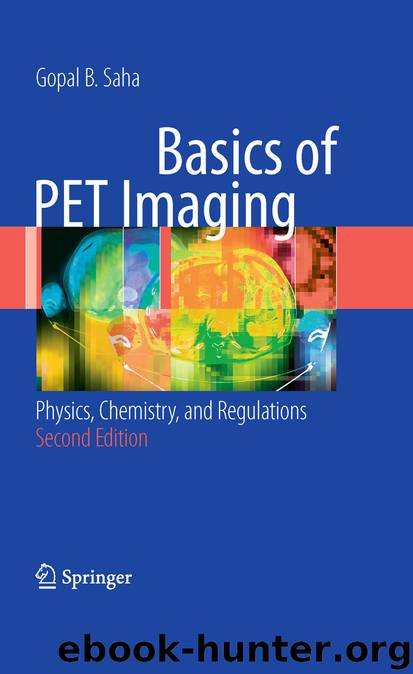Basics of PET Imaging by Gopal B. Saha

Author:Gopal B. Saha
Language: eng
Format: epub
Publisher: Springer New York, New York, NY
(7.1)
where q is the charge of the particle, M is the magnetic field in gauss, r is the radius of the cyclotron, and m is the mass of the particle.
Since negative H− ions do not interact with the nuclei of the target and positive ions do, a 2- to 5-μm-thick and < 4 cm in diameter carbon foil (D) is inserted vertically inside the cyclotron just ahead of the target position to strip two electrons to produce positive ions (i.e., protons), which then can cause nuclear reactions in target nuclei. The carbon foils are loaded in a carousel, and multiple such carousels (e.g., 2–6) are placed in appropriate locations near the exit inside the cyclotron. The carousels are spinned under computer control providing multiple beam lines as needed. The negative ion cyclotron offers the scope of dual bombardments where two targets can be irradiated simultaneously. A carousel containing the carbon stripping foil is inserted in the path of the beam in such a way that only a part of the beam passes through it producing a positive ion beam that is steered out to the beam line leading to a target for radionuclide production. The remainder of the beam is intercepted by a carbon foil in another carousel further down the orbit to produce a second positive ion beam aimed at another target. Two separate targets can be used for the production of two different radionuclides (e.g., 18F and 13N) or two same targets may be used to produce a larger quantity of the same radionuclide. The kinetic energy of the accelerated particles can vary from a few MeV to several hundred electron volts, depending on the size and design of the cyclotron. For a given cyclotron, the external beam energy remains constant, whereas the internal beam energy varies radially inside the cyclotron. Various particles, namely, α particle, proton, deuteron, 3He, and a few heavy ions can be accelerated depending on the design of the cyclotron. The operation of cyclotrons is mostly automatic with minimal manual input and is controlled by the computer.
There are several features that make the negative ion cyclotron operationally more advantageous than the positive ion cyclotron. Beam extraction in a positive ion cyclotron is accomplished by steering the beam along a relatively long channel under the application of an electrostatic force with an extraction efficiency of ∼ 80%. The remaining 20% of the positron beam is lost inside the cyclotron inducing radioactivity in the housing. This obviously warrants more shielding around the cyclotron unit. In contrast, beam extraction in a negative ion cyclotron by carbon foil stripping is a simple method. Because of the short path of extraction and an extraction efficiency of almost 100%, cyclotron housing is not activated by positive ions and shielding requirement is less than in positive ion cyclotrons. In a negative ion cyclotron, the particle beam can be split into several beam lines providing the scope of irradiating several targets simultaneously. On the other hand, a positive ion cyclotron is limited to only a single beam line because of the large size of the electrostatic deflector.
Download
This site does not store any files on its server. We only index and link to content provided by other sites. Please contact the content providers to delete copyright contents if any and email us, we'll remove relevant links or contents immediately.
Periodization Training for Sports by Tudor Bompa(8210)
Why We Sleep: Unlocking the Power of Sleep and Dreams by Matthew Walker(6655)
Paper Towns by Green John(5138)
The Immortal Life of Henrietta Lacks by Rebecca Skloot(4550)
The Sports Rules Book by Human Kinetics(4342)
Dynamic Alignment Through Imagery by Eric Franklin(4176)
ACSM's Complete Guide to Fitness & Health by ACSM(4019)
Kaplan MCAT Organic Chemistry Review: Created for MCAT 2015 (Kaplan Test Prep) by Kaplan(3970)
Introduction to Kinesiology by Shirl J. Hoffman(3743)
Livewired by David Eagleman(3729)
The Death of the Heart by Elizabeth Bowen(3578)
The River of Consciousness by Oliver Sacks(3572)
Alchemy and Alchemists by C. J. S. Thompson(3481)
Bad Pharma by Ben Goldacre(3396)
Descartes' Error by Antonio Damasio(3248)
The Emperor of All Maladies: A Biography of Cancer by Siddhartha Mukherjee(3112)
The Gene: An Intimate History by Siddhartha Mukherjee(3074)
The Fate of Rome: Climate, Disease, and the End of an Empire (The Princeton History of the Ancient World) by Kyle Harper(3032)
Kaplan MCAT Behavioral Sciences Review: Created for MCAT 2015 (Kaplan Test Prep) by Kaplan(2957)
